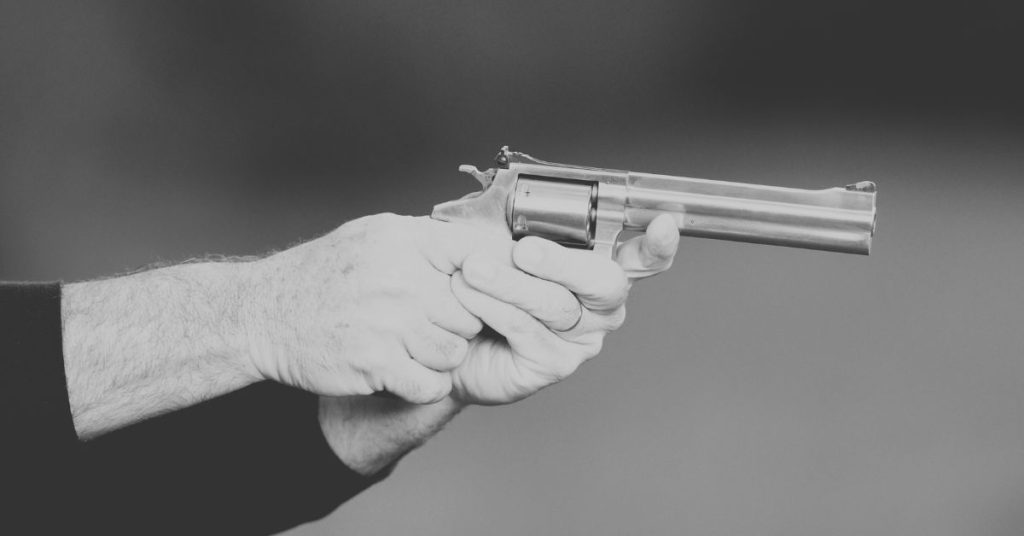The iconic .357 Magnum ammo stands out as a top home defense round. Choosing a gun and ammo for home defense is much different than choosing one for self-defense. Most experts say that using a shotgun for home defense is the way to go.
Easy to shoot with less chance of liability or collateral damage. This is true. However, 00 buckshot isn’t always a deterrent to an intruder in your home.
Additionally, not everyone can operate a shotgun as easily as a handgun. Lastly, homeowners can conceal a handgun easier than a long gun, making it easier to get to in the moment.
A .357 Magnum revolver makes an excellent choice for home defense. The .357 Magnum ammo provides reliable accuracy with adequate stopping power.
Homeowners sleep better knowing the family is protected by one of the most classic types of ammunition on the market. Experts laud .357 Magnum ammo for its versatility.
Shooters choose the round because it is inexpensive, readily available, and usable for plinking, hunting, range training, target shooting, and home defense. More powerful ammunition exists but the .357 is easy to control and easier to shoot.
Some object to using a .357 as a home defense weapon because of the excess weight. The argument proves valid if the gun is for concealed carry. However, a home defense weapon stays in the home, hopefully in a lockbox, until needed.
Handgun vs. Rifle
.357 Magnum ammo brings versatility to the table in that it can be used in a handgun or a carbine. The impressive round fires at about 1,400 FPS from a revolver and 1,800 FPS from a rifle.
The developers created the round to be strong enough to confront criminals, including those wearing ballistics vests. While a neighborhood intruder is unlikely to wear a bulletproof vest, the stopping power is still important.
Such power presents a possible downside in that it can go through drywall or a door, causing collateral damage.
Using a .357 Magnum Revolver
Pop culture makes carrying a large caliber gun fashionable. A Colt .45 will scare an intruder but do little else if the gun is too much to handle. a .357 Magnum revolver backs up the threat to protect the home and the people inside. Benefits to using a .357 Magnum revolver include:
Easy handling. Revolvers, especially those with longer barrels, are easy to aim and shoot. The heavy weight benefits the shooter with superior accuracy. They also allow the user to fire quickly.
Revolvers operate without fuss. Revolvers belong in the “what you see is what you get” category. The shooter forgoes adjusting bells and whistles. Point and shoot. Home defense situations call for fast action.
Revolvers remain popular which means they are affordable and easy to find.
Lastly, .357 revolvers fire .38 Special rounds. The rounds match in every way but their length. Shooting less powerful ammo helps novices handle the recoil. It also allows for a lighter trigger pull on guns with a short barrel length, like a snubnose.
Advantages of .357 Mag Ammo
Shooters credit .357 ammo with power and ease of use. Some advantages to the ammo include:
- Various factory loads. Most manufacturers produce a wide variety of bullet weights and types for .357 Mag. From 110 grains to 180 grains.
- Reload with ease. Handloaders save money and experiment with reloading .357 cartridges to create bigger and better rounds.
- Easy to find. Most stores, outlets and online sites carry .357 ammo. This makes it simple to comparison shop and buy in bulk.
Specs
Smith & Wesson ordered changes to Elmer Keith’s original bullet design. The bullet was reshaped to Philip Sharpe’s specifications. Today, the .357 S&W Magnum rimmed centerfire cartridge with a .357 inch (9.1mm) diameter bullet.
The case measures 1.29 inches in length. The total length of the round is 1.59 inches. SAAMI states the maximum pressure is 35,000 PSI; average muzzle velocity is 1,090 feet per second (FPS).
Bullet Types
An experienced shooter knows bullet types and their uses. Manufacturers create new bullet types to accommodate popular calibers like.357 Magnum.
Common styles include Full Metal Jacket, Jacketed Soft Point, and Jacketed Hollow Point. The list below shows the three common types of bullets and their uses.
Full Metal Jacket (FMJ)
FMJ bullets cost less than hollow points or soft points. This makes them ideal for high volume shooting including range or target practice. The bullet houses a soft center metal like lead, surrounded by a harder metal, usually copper.
FMJs work best for short-range shooting, plinking, target practice, range training, and competition shooting.
Hollow Points (HP)
Hollow points relate mostly to self-defense and home protection. HPs cost more than FMJs, however, the round performs better in face-to-face confrontations. The ballistics of HPs are comparable to the FMJ.
The HP design allows the bullet to expand, creating a larger wound channel than the FMJ. The expansion stops attackers quickly and therefore, the shooter is protected.
Soft Points (SP)
Hunters choose soft points over most other ammunition. SPs expand more than an FMJ, which creates ideal stopping power. SPs compare to HPs, except for the expansion.
An SP allows the shooter to have more control. SP ballistics outshine other bullets, especially when they are made with a boat-tail design. Jacketed Soft Points (JSP) are another option.
Bullet Weights
Bullet weights control the power of the projectile as it leaves the gun barrel. The number of grains determines the weight.
Heavyweight Bullet Characteristics
Heavy bullet weights lower the velocity of the ammo. A heavy bullet works well in short-range situations including home defense. It is less affected by weather or minor changes in wind. The downsides include heavier recoil and the likelihood of over penetration.
Lightweight Bullet Characteristics
Lightweight bullets travel fast. The lighter the bullet, the faster it travels. The lightweight means the bullet will retain a better trajectory, and therefore, accuracy at long distances. The bullet’s high velocity brings with it the chance for over penetration. An advantage is less recoil.
Best .357 Magnum Ammo for Home Defense
Experts showcase top choices for .357 for home defense. Each brings the power, accuracy and velocity needed in any home defense situation. The downsides for the .357 include a bright muzzle flash, stiff recoil, and loud report.
These items distract newbies from maintaining accuracy on multiple shots. However, using a bullet with fewer grains will lessen these issues. Ammo types and weights should be based on the shooter’s knowledge and skill level. Practice is imperative.
Top choices for home defense ammo include:
Federal Ammunition 158 Grain JHP
- 1,240 FPS Muzzle Velocity
- 158 Grain
- Jacketed Hollow Point Bullet
- Nickel-plated Brass Casing
- Boxer Primer
- 539 ft-lbs. Muzzle Energy
Buffalo Bore Tactical Short Barrel 158 Grain JHP
- 1,400 FPS Muzzle Velocity
- 158 Grain
- Jacketed Hollow Point Bullet
- Nickel-plated Brass Casing
- Boxer Primer
- 606 ft-lbs. Muzzle Energy
Federal American Eagle Cartridge 158 Grain JSP
- 1,240 FPS Muzzle Velocity
- 158 Grain
- Jacketed Soft Point Bullet
- Nickel-plated Brass Casing
- Boxer Primer
- 530 ft-lbs. Muzzle Energy
Fiocchi 142 Grain FMJ-TC
- 1,420 FPS Muzzle Velocity
- 158 Grain
- Full Metal Jacket Bullet
- Nickel-plated Brass Casing
- Boxer Primer
- 636 ft-lbs. Muzzle Energy
Speer Gold Dot Short Barrel 135 Grain JHP
- 990 FPS Muzzle Velocity
- 135 Grain
- Jacketed Hollow Point Bullet
- Nickel-plated Brass Casing
- Boxer Primer
- 294 ft-lbs. Muzzle Energy
Hornady Critical Defense 125 Grain FTX
- 1,500 FPS Muzzle Velocity
- 125 Grain
- FlexTip Bullet
- Nickel-plated Brass Casing
- Boxer Primer
- 824 ft-lbs. Muzzle Energy
CCI Blazer 158 Grain JHP
- 1,150 FPS Muzzle Velocity
- 158 Grain
- Jacketed Soft Point Bullet
- Nickel-plated Brass Casing
- Boxer Primer
- 464 ft-lbs. Muzzle Energy
Tula Ammo 158 Grain FMJ
- 1,280 FPS Muzzle Velocity
- 158 Grain
- Full Metal Jacket Bullet
- Steel Casing
- Boxer Primer
- 464 ft-lbs. Muzzle Energy
Barnes 140 Grain VOR-TX JHP
- 1,265 FPS Muzzle Velocity
- 158 Grain
- Jacketed Soft Point Bullet
- Copper Casing
- Boxer Primer
- 498 ft-lbs. Muzzle Energy
Federal Premium Power-Shok 158 Grain JHP
- 1,240 FPS Muzzle Velocity
- 158 Grain
- Jacketed Hollow Point Bullet
- Nickel-plated Brass Casing
- Boxer Primer
- 539 ft-lbs. Muzzle Energy
Ruger ARX 86 Grain
- 1,650 FPS Muzzle Velocity
- 86 Grain
- Injection Molded Copper Polymer ARX Projectile
- Brass Casing
- Boxer Primer
- 552 ft-lbs. Muzzle Energy
Hornady American Gunner 125 Grain JHP XTP
- 1,500 FPS Muzzle Velocity
- 125 Grain
- Jacketed Hollow Point Bullet
- Nickel-plated Brass Casing
- Boxer Primer
- 624 ft-lbs. Muzzle Energy
PMC Bronze 158 Grain JSP
- 1,471 FPS Muzzle Velocity
- 158 Grain
- Jacketed Soft Point Bullet
- Nickel-plated Brass Casing
- Boxer Primer
- 759 ft-lbs. Muzzle Energy
Sellier & Bellot 158 Grain FMJ-FN
- 889 FPS Muzzle Velocity
- 158 Grain
- Full Metal Jacket Bullet
- Nickel-plated Brass Casing
- Boxer Primer
- 278 ft-lbs. Muzzle Energy
Federal Premium Barnes Expander 140 Grain JHP
- 1,400 FPS Muzzle Velocity
- 140 Grain
- Jacketed Soft Point Bullet
- Nickel-plated Brass Casing
- Boxer Primer
- 609 ft-lbs. Muzzle Energy
Remington Ammunition: 110 Grain SJHP
- 1,295 FPS Muzzle Velocity
- 110 Grain
- Semi Jacketed Hollow Point Bullet
- Nickel-plated Brass Casing
- Boxer Primer
- 410 ft-lbs. Muzzle Energy
Conclusion
Experts never agree on the ultimate home defense ammunition. However, .357 Magnum ammo appears at the top of the list due to its stopping power, accuracy, availability, and reliability.
The ammo carries the power necessary to dominate in any situation in a revolver or lever-action carbine.
Where larger calibers bear the burden of possible over penetration, the .357 ammo is less likely to go through the target to cause collateral damage. The .357 Mag ammo gives the homeowner peace of mind, knowing that the protection is there if needed.

